Homemade Cement Succulent Planter (Step by Step)
Make an easy homemade succulent planter from cement. Here’s a written and video tutorial for this fun DIY.
If you read my cement bird bath tutorial post or watched the video version of the tutorial, then you’ll see that this flower-shaped succulent planter is strongly inspired by that.
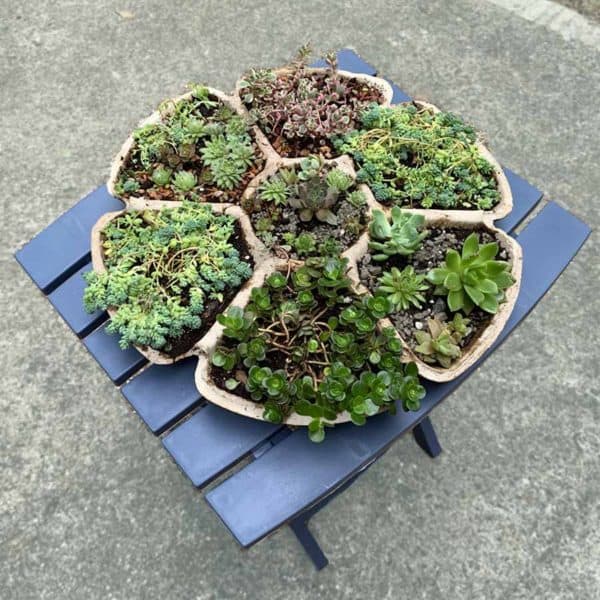
While making the bird bath, I thought of another way to utilize the cool Dollar Tree chip and dip tray -make a multi-compartment succulent planter!
I thought it would be so nice to see a larger selection of succulents in one place. I guess you could call it a chip and dip tray re-purposed to a bird bath mould, re-purposed again.
The hardest thing about this for me was figuring out what type of succulent to plant where. I’m so not good at arranging plants.
Homemade Cement Succulent Planter Video
Please click the button to subscribe to my YouTube channel and be notified when I have a new video tutorial!
I had a decent assortment of succulents on hand to choose from, but creating the right layout was a challenge.
Keep in mind I’m a kitchen designer by day- so these things shouldn’t be so hard? Ha!
Here’s the tutorial I mentioned where I used the same Dollar Tree mold to make a DIY cement bird bath!
Here’s another succulent planter made with cement –with a cute succulent plant design.
And if you like interesting planters, then check out the ideas for 21 unique DIY concrete planters.
Please ask me questions if you get stuck!
Some of the links on this page have been provided as a convenience for finding materials. These links may also be affiliate links. As an Amazon Associate I earn from qualifying purchases, at no extra cost to you.
I only recommend products I’ve used and loved, unless otherwise stated. Click here to read my full disclosure policy.
Difficulty Level | Easy
Materials for making a Homemade Cement Succulent Planter
- Petal shaped plastic mould (2)
- Rapid set cement
- Disposable plastic bowl
- Disposable plastic cup
- Disposable measuring cup
- Durable nitrile gloves
- Hot glue gun
- Glue sticks
- Chisel or metal file
- Sanding block
- Power drill
- Drill bit that is the same diameter as your glue stick
- Measuring tape or ruler
- X-acto knife- preferably with longer blade than standard



Before starting the tutorial, it may be helpful to read my article comparing the different concrete mixes and sealers– Cement & Concrete Crafts Tests!
Another important article is Making Cement Crafts Techniques & Tips with info on cement materials, mixture consistencies, demolding, safety and clean up!
Homemade Cement Succulent Planter Tutorial Steps
Step 1. Trim The Glue Stick

First heat up the glue gun. While that’s heating up, take the glue stick and measure out one piece, somewhere between ⅝ and ¾”.
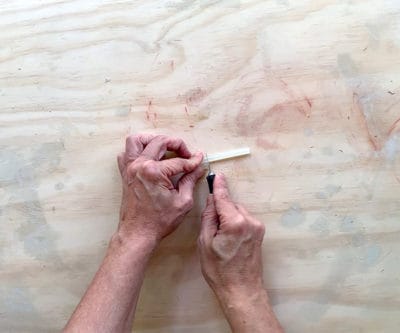
Then use that piece as your template for the rest of the pieces. You will need 14 of them, so take the X-acto and trim each piece.
Step 2. Glue The Glue Sticks
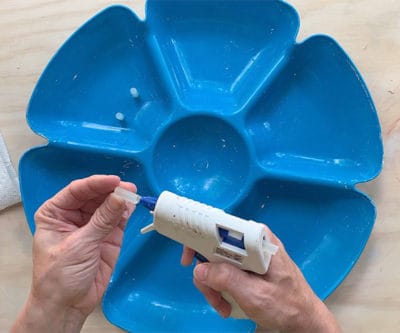

Sounds weird, huh? Yep, in order to create drainage holes for your cement planter, you’ll want to hot glue each of your glue sticks to the bottom of the plastic petal mould.
I glued two pieces in each petal and the center.
There’s so much you can do with Dollar Tree supplies. Here are 39 Dollar Tree Christmas Crafts made with dollar store items. And this post has Fall DIY Dollar Tree Crafts.
Step 3. Mix The Cement

With the disposable plastic cup and disposable measuring cup, pour in the dry cement and some water.
Start mixing slowly, be sure to wear gloves, and when each batch has no lumps, then add another scoop and more water.
It’s important to mix the cement in batches to keep the consistency smooth.
All together I added about 6 cups of mix, so my bowl was about 3/4″ of the way full.
You need enough cement so that when you add the second plastic mould, the cement will spill over the sides.
Step 4. Pour The Cement Mixture Into The Mould
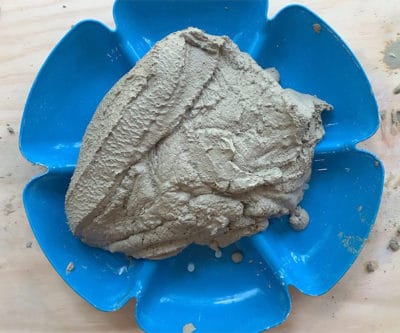
So now that the cement is fully mixed, you can pour it into the mould that has the glued hot glue sticks.
You’ll know that you made enough cement mix if the mould is nearly full.

Pat the cement down into the petals and shake the cement mould until you have the cement level in each petal.
And if air bubbles rise, pop them and shake until most of the air bubbles are gone and everything looks even.

This next step gets a bit messy, so take a plastic garbage bag and place it underneath the take the 2nd mould piece and push it down on top of the one with the concrete and press firmly, using some body weight for pressure.
There will be resistance once you hit the glue sticks, and it’s okay to keep applying some pressure on them.

You will have excess cement coming out of the moulds, this is good- it means you probably have enough cement in there.
Just wipe off the excess so that you don’t end up with undercuts that will make removing the cement difficult.
Now let it cure for at least 2-3 hours. If it is still warm to the touch, then wait until there is no heat coming off of it.
Step 5. De-mould The Cement Planter


Take off the top mould and then place an old towel underneath and remove the cement from the bottom mould and if it is sticking, just carefully work the plastic away from the cement.
Step 6. Remove The Glue Sticks

Next, keep the towel underneath and remove the glue sticks from the cement planter by using the power dill.
This step took a little bit of time to do- probably 15-20 minutes.

Take the drill carefully and drill out the pieces of the glue stick from the bottom of the succulent planter, most of which should be visible from underneath.
You may need to pull the drill in and out to get the pieces out. Be careful to drill only the glue and the cement so that you don’t accidentally crack it.

Note: The friction from the drill makes the bit get hot and it will start melting the glue stick, making each one subsequently more difficult to get out.
Therefore you will need to clean the bit after a handful of sticks have been removed. I used my X-acto to assist with this.
Step 7. Sand The Planter


The cement planter is ready for finishing. You can file or chisel the rough edges and sand.
I used a chisel and took down the sharp edges to make it look and feel smoother.
After that, I used the sanding block to finish it up- though it really didn’t need much sanding.
Step 8. Plant The Cement Planter
Finally, it’s time for planting. Fill it with soil and add the plants to your homemade cement succulent planter.
Please show me pics of how you end up arranging yours!
Don’t forget to Pin it for later!
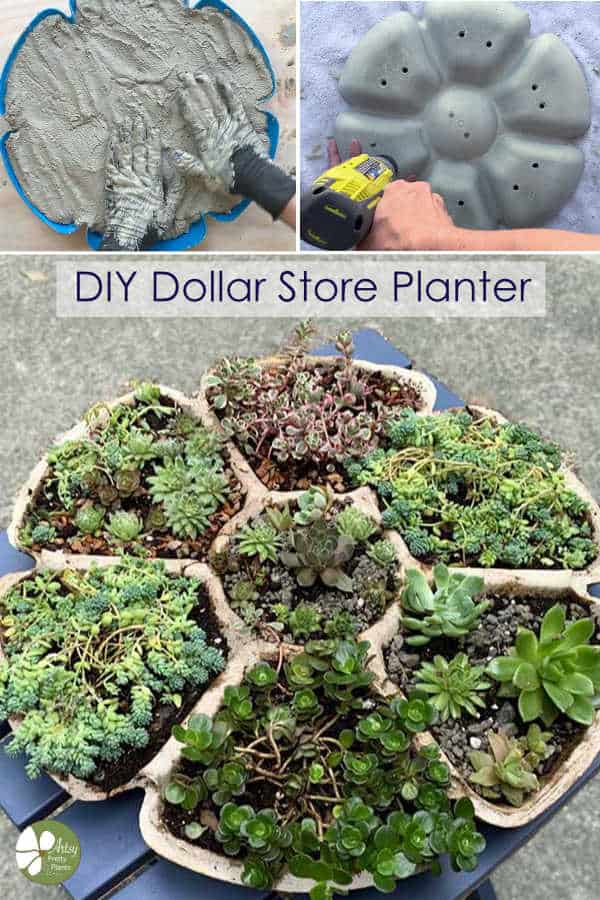
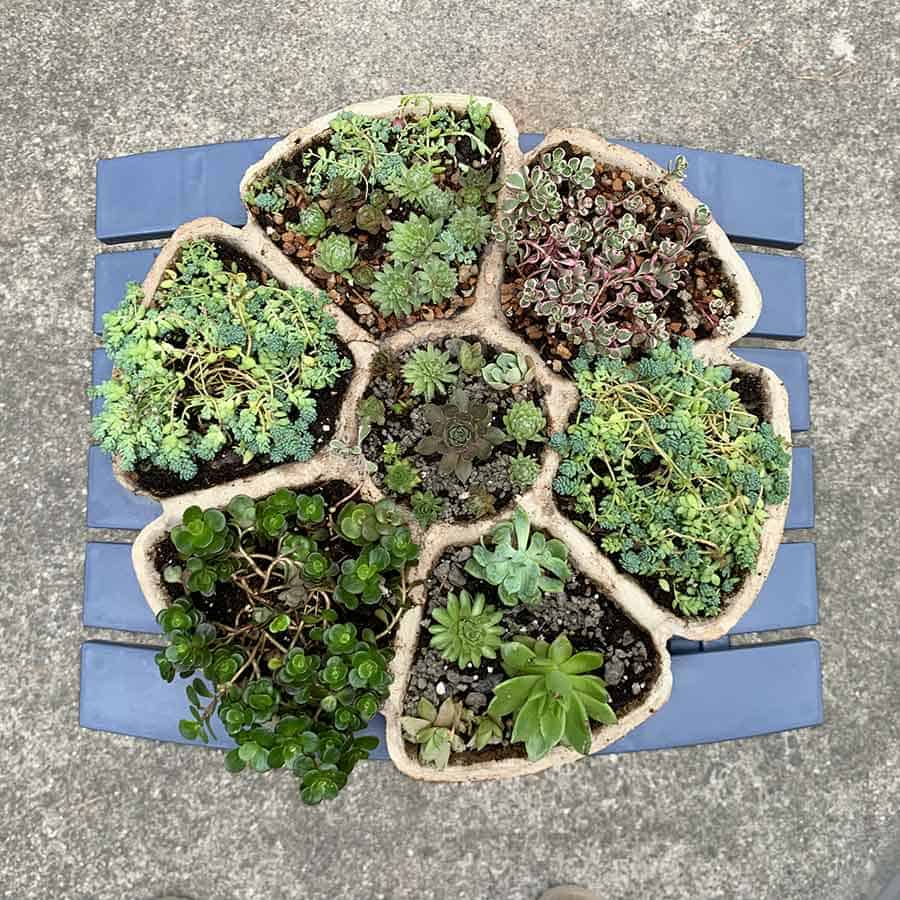


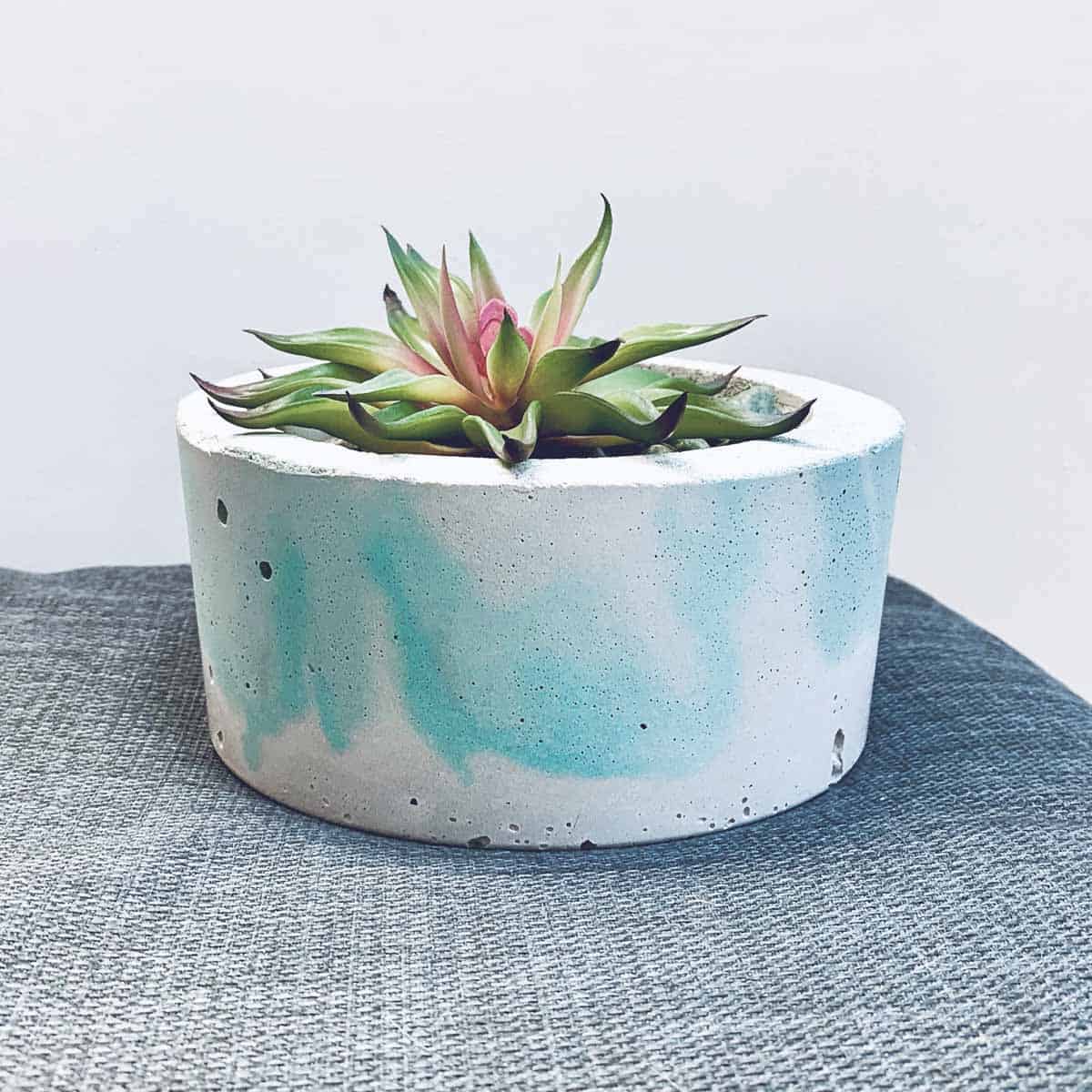



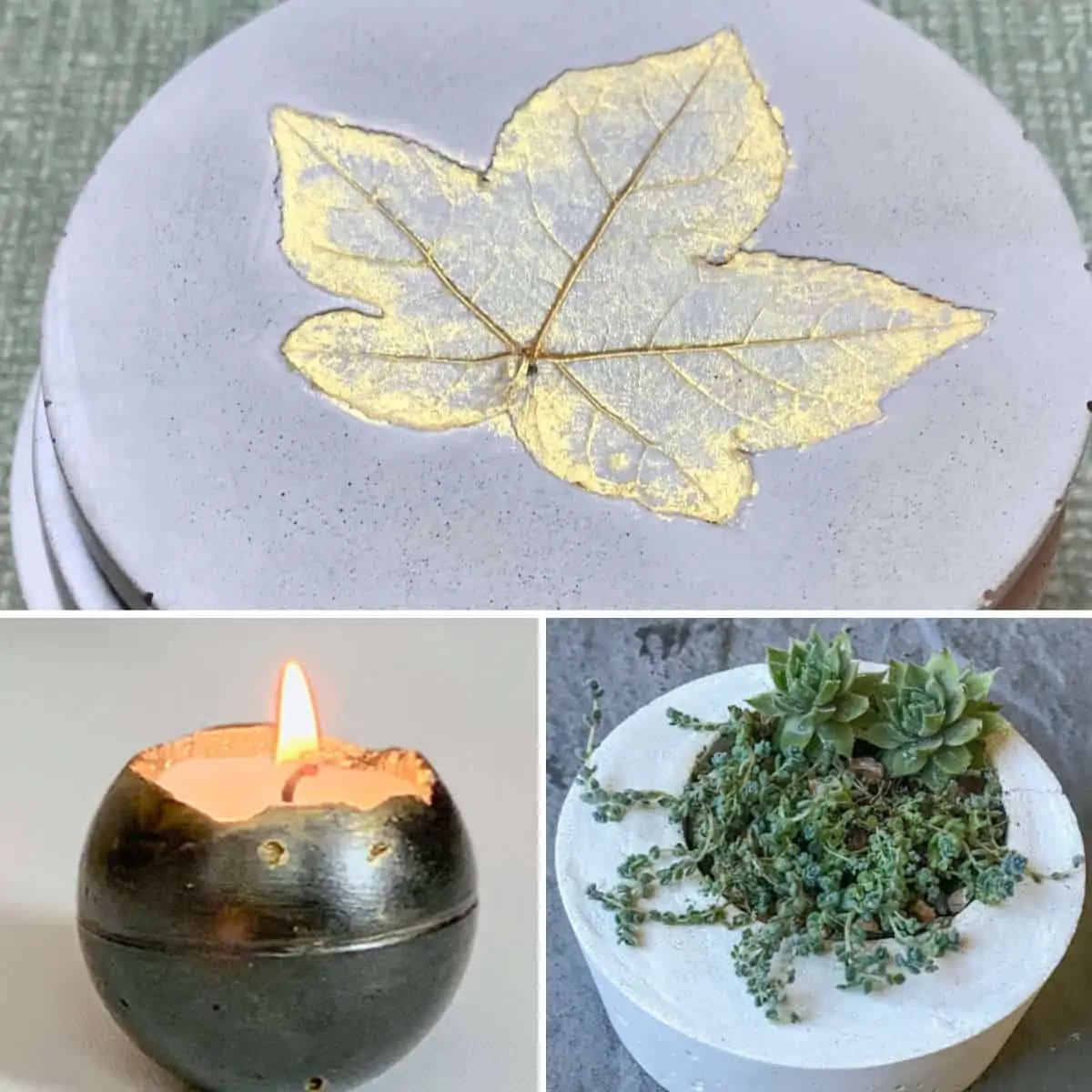

Love this planter. Going out to search the dollar store for something to use as forms.
Thanks Mary. Did you find your form?
Love this! I have the same issues arranging succulents. I wonder if there isn’t an easier way to make the drainage holes.
Hi Karen,
Thanks! I know, the drainage holes are often the trickiest part of engineering these cement planters. You could cut up pieces of a straw but you have to make the ends solid so the cement doesn’t get inside. On other projects I have done more recently, I have just been filling each end of the straw with hot glue and that’s been working pretty well.
Then just glue the straw to the chip mold. It probably won’t be perfect, but you should be able to pull most of the straws out of the mold without needing the drill.
Maybe a soldering iron would melt the glue stick? Looking forward to trying one of your projects.
Hi,
That’s a really good idea. It probably would make it much easier. Thanks!